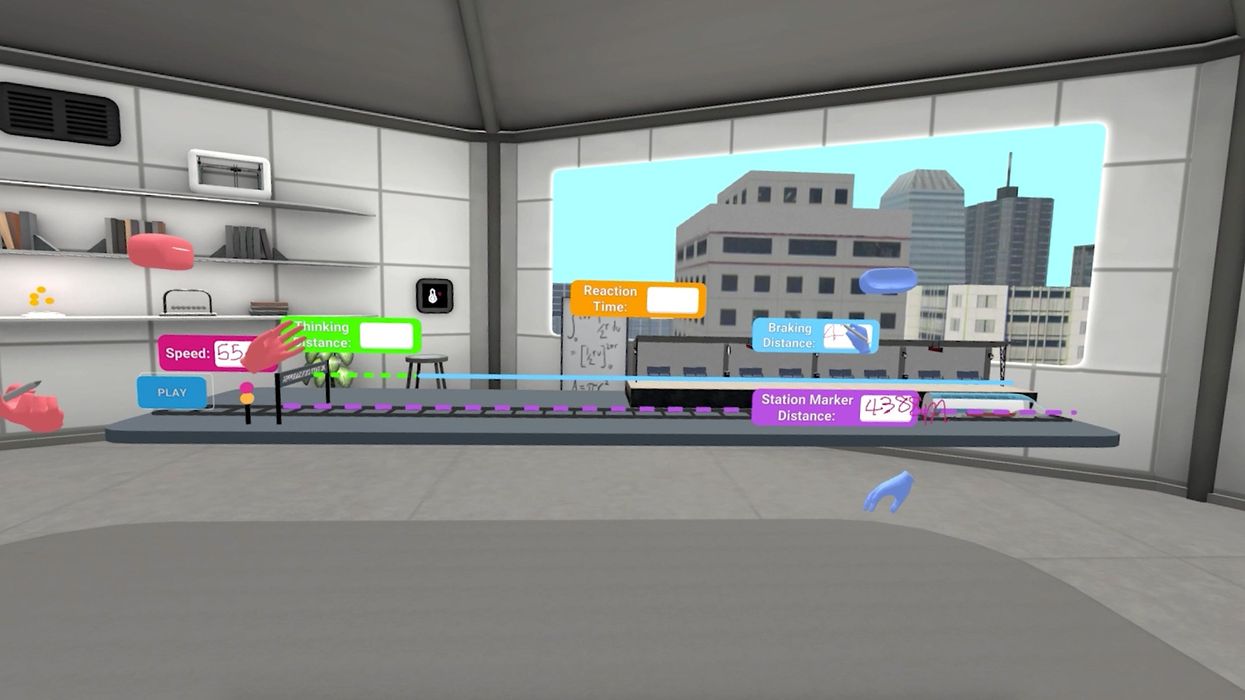Virtual Reality Helps Students Improve Their Math Literacy

Many students struggle to learn mathematics. In the United States, eighth graders scored an average of 271 out of 500 in math on last year's National Assessment of Educational Progress, as highlighted in a New York Times article. It's the lowest level in decades. Black, Native American, and low-income students had particularly low math scores on the federal standardized test.
One way teachers are trying to help students grasp difficult concepts is through virtual-reality technology. VR headsets allow students to immerse themselves in realistic digital environments to learn math and science by solving real-world problems, such as calculating how high a house's foundation should be raised to offset the risk of flooding.
Thanks to Prisms of Reality, VR technology is being used in 140 school districts in 30 states. IEEE Member Anarupa Ganguly founded Prisms VR, as the startup is known, in 2020. The San Francisco-based company helps educators teach math to preuniversity students.
Prisms VRFounded
2020
Headquarters
San Francisco
Founder
Anarupa Ganguly
Prisms VR's learning platform," Ganguly says, is taking problems from textbooks and bringing them to life."
She has first-hand experience in education: She taught math and physics in Boston-area high schools. She also served in executive positions in Boston public schools, New York City public schools, and Success Academy charter schools, also in New York City.
The startup's VR learning platform offers math and science lessons that simulate real-world locations and situations. Students are asked to complete tasks based on what they are learning.
The platform's math component, called Prisms Math, was released this year.
Making sense of mathGanguly and a team of engineers developed the platform's software, which includes modules on physics, biology, and chemistry as well as math. Each module covers one topic within the relevant subject. There are six algebra modules, for example, including ones about linear functions, quadratics, and exponentials.
The software is compatible with Meta and Pico headsets, and Prisms VR is working to make it run on Apple's new Vision Pro.
Displayed on the student's VR headset is a list of modules. Based on what module is chosen, the pupil is transported to a corresponding virtual location to complete tasks as a way of learning the material. In the chemistry module on acids and bases, for example, students are shown a computer-generated version of a wastewater-treatment plant in Baltimore, and they try to make chemically contaminated water safe to drink. The students learn about the key properties of acids and bases and the neutralization formula, which they use to determine the amount of basic solution required to neutralize the acidic water.
Using Prisms's web-based dashboard, teachers can track the students' progress and provide feedback on their work, which appears on the learner's virtual watch.
The watch allows for a constant dialog between the teacher and kids," Ganguly says.
Each virtual session ends 10 minutes before class is dismissed to allow the instructor to discuss what the students have learned. It takes about three days to complete a module.
Ganguly says the learning platform is a supplemental program, as VR is not for everyday use; it's for learning concepts that students find more difficult to understand."
She used her teaching experience to develop the system, and she partnered with nonprofit WestEd to research whether VR could be effective in teaching science, technology, engineering, and mathematics. WestEd, based in San Francisco, aims to create a more equitable society by improving education through professional learning, technical assistance, and policy guidance.
Together with Prisms VR, WestEd studied how feasible it would be for students to complete a lesson using VR in a 45-minute class. It found that 35 minutes was the optimal length for a lesson.
 Anarupa Ganguly founded Prisms VR in 2020 to help improve math literacy using technology.Prisms VR
Anarupa Ganguly founded Prisms VR in 2020 to help improve math literacy using technology.Prisms VR
Teachers also reported that the children learned a topic faster with the headset," Ganguly says. A lesson that usually took three to four weeks to teach took only one week. These findings proved to me that Prisms VR could be successful."
Ganguly develops the software and educational content. It currently takes her three weeks to write a module.
We scope out the concepts that students have a hard time learning and create a prototype to get it out to schools quickly," Ganguly says. We receive feedback from students and teachers about the modules and update them as needed. The system is essentially being designed alongside the schools that are using it."
While visiting the schools to gain a better understanding of how the platform is being used, she talks with teachers about their experiences.
Traveling and having a personal connection to Prisms VR customers," she says, has been really valuable in designing and updating the modules."
The teachers say they can tell the platform was designed by an educator," she adds. I've never had a teacher opt out of using the platform."
The platform's equipment, which includes 35 headsets and chargers, costs US $20,000 per classroom. The software, including the modules and web-based dashboard, costs $12 to $14 per student.
For students who want to practice their math skills at home, a monthly subscription of $24 to Prisms Math is available from the Meta Quest store.
STEM at the rootGanguly says she was inspired to help reform STEM education when she was a graduate student at MIT. She noticed that there weren't many graduate students who were women or people of color.
Believing that was connected to inadequate preuniversity STEM education, Ganguly says, she figured the best way for her to address the problem was to become a teacher. After earning a master's degree in electrical engineering from MIT in 2009, she went on to earn a master's degree in education in 2011 from Boston University.
She taught algebra and physics at high schools in Boston until 2014, when she became the director of mathematics for the Boston school district, made up of 125 schools and 55,000 students.
In 2015 she moved to New York City, where she worked for its Education Department to train teachers in 188 underserved schools how to use a new system for math the department had introduced. A year later she began serving as the department's senior director of instruction and professional learning, supporting about 1.2 million students in the system's 1,800 schools.
She left in 2017 and joined Success Academy as dean of mathematics. The network of 47 public schools is independent of the state's system.
She began researching what skills and knowledge preuniversity students were missing that was preventing them from completing a university STEM program.
Her literature review showed two main indicators of success for university students pursuing a STEM degree: the ability to visualize and manipulate objects in their mind (spatial reasoning) and the ability to create abstract representations of real-world experiences.
Ganguly wanted to use her engineering know-how to develop a technology that could teach youngsters those skills. So in 2020 she left Success Academy to start Prisms VR.
The startup received grants from the U.S. National Science Foundation, the National Institutes of Health, and the Gates Foundation. This year venture-capital firm Andreessen Horowitz of Silicon Valley invested $12.5 million.
Continuing to increase accessibilityPrisms is working with the Gates Foundation and WestEd to improve STEM education in the United States.
One of the studies being conducted with the Gates Foundation is examining whether the startup's learning platform increases student retention at universities. The 10-year study is being conducted in Arizona.
Prisms VR and WestEd this year completed a randomized controlled trial across 36 schools in Ohio that tested whether the startup's platform helped students learn the curriculum better and faster than with traditional methods. According to Prisms VR, students using the platform have a deeper understanding of the material, are more confident in their skills, and enjoy learning math more. Standardized test scores increased by 11 percent in one year, the company says.
Prisms VR also is developing modules for college-level STEM courses including calculus, multivariable algebra, linear algebra, and differential equations. The modules are expected to be released at the end of next year.
I think," Ganguly says, that having students use VR to learn STEM subjects is going to transform education."